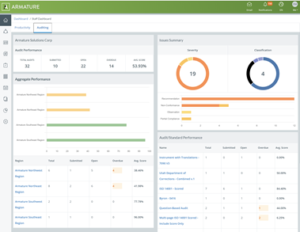Over the past 20 years ARMATURE has delivered more than 100 accreditation and certification management software implementations. When we first began delivering software to customers in the early 2000s, almost everything we did was custom and it would be some time before we would focus on how to manage issues and risks. Over time we realized that this way of doing things was cumbersome, expensive, inconsistent, and challenging to upgrade. Based on our collaboration with the accreditation and certification community we built a feature-rich product, ARMATURE Fabric, to do exactly the opposite:
- Enable faster delivery
- Engage constituents easily and effectively through an easy-to-use interface
- Provide enhanced task and performance management tools
- Reduce implementation and maintenance costs
- Conduct upgrades quickly and effectively
- Be more responsive from a customer support perspective
- Integrate easily
- Create a faster time to value
The first iteration of ARMATURE Fabric was developed in 2011. Since then we have consistently updated the software to meet the changing needs of the accreditation, certification, and audit management communities. In this article, we provide insight into how we have evolved our product to help our customers focus on managing issues and risks.
Moving from audits and assessments to issues and risk management
There has been much discussion in the accreditation, certification, and audit communities in the last few years about managing issues and risk more effectively. Each discussion varies depending upon the nature and type of accreditation (from hospital accreditation to educational programs). ARMATURE began working on our issues management functionality nearly two years ago to help accreditors, certification bodies, and auditors to identify issues, track, and resolve them. Let’s take a deeper dive and review what this functionality looks like today and, more importantly, how it can help improve quality and minimize risk.
Tracking issues is a way to surface key challenges and opportunities – especially when the same or similar issues are happening frequently across your customer base. Think of a site visit team conducting an audit of a facility or program. They may flag certain criteria within an assessment as being unmet which can trigger an issue management process. This process allows for follow up actions and evidence capture and ultimately results in a resolution.
Being able to track, triage, and resolve issues can help organizations and institutions to continuously improve. In addition, when issue data is aggregated it can enable auditors, accreditors, and certification bodies to identify high level trends. These trends could, in turn, help to influence how standards evolve, enable you to provide better guidance to those being audited and assessed, and help drive quality across the board.
Issues Management and ARMATURE Fabric
The issues management feature in ARMATURE Fabric allows organizations to do the following:
- Log issues
- Initiate an issue management process
- Track version history (e.g., capture the value(s) of issue fields, from name to resolution, every time a user makes a change or update)
- Track analysis and actions taken
- Monitor issue resolution (allows external users to group issues easily, view their artifacts (evidence), and provide multi-step resolution, including root cause analysis)
We are also working on developing more advanced features that will enable enhanced insights for executives.

Features include:
- The ability to allow executive stakeholders to view audit results and issues across all customers and business units
- The ability to allow “click-through” analysis to hone in on specific challenges and opportunities
- The ability to display issues by criteria and audit type
- The ability to show resolution times and outstanding issues (beyond SLA commitments); this will include assignment bottlenecks (where the assignment feature is turned on)
By implementing these new capabilities, we’re able to equip executive teams with the information they need to make positive changes within and for their stakeholder community. Ultimately, this will lead to quality enhancements and more effective risk management.


